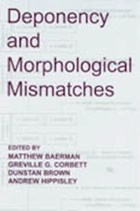Extended deponency: The right morphology in the wrong place
Annotated bibliography on deponency
This bibliography contains summaries of works which focus on the theoretical implications of deponency or deponency-like morphological mismatches.
How to cite
Baerman, Matthew. 200X. Annotated bibliography on deponency. University of Surrey.
Bibliography
Anderson, Stephen R. 1992. Syntactically arbitrary inflectional morphology. In Geert Booij & Jaap van Marle (eds.), Yearbook of Morphology 1991, 5-19. Dordrecht: Kluwer.
Discusses various examples of 'mismatches between syntactic structure and the inflectional markings associated with it'.
Algonquian languages distinguish 4 verb types (animate/inanimate intransitive/transitive). but a number of verbs are inflected transitively even though they don't (necessarily) take a direct object (examples from Menomini & Fox). Anderson speculates that it originated in a normal construction which developed an idiomatic sense.
Georgian: (a) inversion verbs, (b) class III 'medial' vbs, which systematically inflect for a direct object., even though only a few are able to take one syntactically (Anderson concludes that these are syntactically intransitive, and have mismatched inflection).
Tsova-Tush: 1st and 2nd person intransitive subjects of some verbs are marked with nominative or ergative, depending on 'relative agentness',while with 3rd person arguments, nominative is used for intransitives and ergative for transitives. But there are a small number of intransitives whose subjects are always ergative for all 3 persons.
The above examples involve inflection indicating an argument not present in syntax; the reverse occurs in Algonquian again, where intransitives may take objects; note that this class in Ojibwa has innovated object marking for these verbs. In Maliseet, there are morphological intransitives, but they can only take objects which do not need to be indicated inflectionally (i.e. they can't have 1st or 2nd person object, nor a proximate object).
Georgian inversion: Anderson notes Harris's argument that it involves a reorganization of clause structure, but doesn't agree (arguments in detail in Anderson 1984); reasons for thinking that notional subjects & objects are also structural subjects and objects come from: (i) word order, (ii) reflexivization, and (iii) number agreement.
Direct/inverse in Algonquian (Cree). Anderson does not think they involve a reversal of grammatical postioning (akin to passivization) that some have argued.
Such mismatches argues for a modular grammar.
Bickel, Balthasar and Johanna Nichols. 2001. Syntactic ergativity in light verb complements. In Charles Chang, Michael J. Houser, Yuni Kim David Mortensen, Micha Park-Doob and Maziar Toosarvandani (eds.), Proceedings of the 27th Annual Meeting of the Berkeley Linguistics Society: General Session and Parasesion on Gesture and Language, 39-52. Berkeley: University of California.
The Kiranti (Tibeto-Burman) language Belhaare has a class of what the authors call 'superlight' verbs (auxiliaries and modals), which mirror the transitivity of the main verb. Thus, a superlight verb used with a transitive main verb marks subject and object the same way as a transitive verb, and a superlight verb used with an intransitive main verb marks its subject like an intransitive verb. However, there are some superlight verbs which the authors identify as deponent. They are morphologically transitive or intransitive, but this is lexically specified by the superlight verb itself, rather than being sensitive to the transitivity of the main verb.
Bobaljik, Jonathan D. & Phil Branigan. 2006. Eccentric agreement and multiple case checking. In Alana Johns, Diane Massam and Juvenal Ndayiragije (eds.), Ergativity, 47-77. Dordrecht: Springer.
Addresses the issue of the Chukchi 'spurious antipassive'. In Bobaljik and Branigan's syntactic model, the relationship between antipassive and transitive in an ergative system is one of movement: in an antipassive the object is low (in its original position) while in a transitive construction it has been raised to be adjacent to the subject. Spurious antipassive is induced by a person hierarchy which bans certain subject-object combinations (in an already complete syntactic construction). This is achieved by deleting the lower argument (object). Since this is post-syntactic deletion, the lower copy of the argument is activated, so that the resulting structure is identical to that of an antipassive. (Thus, there is a real syntax-morphology mismatch.)
This model is said to make the following prediction: you can get an antipassive induced by argument relations, but not a passive, because deletion only happens under conditions of direct subject-object adjacency, which only occur in an ergative construction.
Börjars, Kersti, Nigel Vincent & Carol Chapman. 1996. Paradigms, periphrases and pronominal inflection: A feature-based account. In Geert Booij & Jaap van Marle (eds.) Yearbook of Morphology 1996, 155-180. Dordrecht: Kluwer.
Deponent verbs in Latin are used to argue for the inclusion of periphrastic constructions as part of the inflectional paradigm. Specifically, the finite periphrastic perfect forms of deponent verbs are morphosyntactically identical to the synthetic forms of normal verbs; in as much as the latter are unquestionably part of the inflectional paradigm of the verb, the former should be construed as part of the paradigm as well.
Embick, David. 2000. Features, Syntax, and Categories in the Latin Perfect. Linguistic Inquiry 31(2). 185–230.
Includes a discussion of deponent verbs. Typically, the feature [passive] is associated with syntactic configurations in which there is no external argument. However, in the case of deponent verbs, it is associated directly with the root, whereby '... the feature [pass] is actually interpreted when it appears on v, but not interpreted when it appears arbitrarily with deponents.' On the assumption of early insertion of roots, this means that deponent verbs behave syntactically as passives (in particular, they form periphrastic perfects), without having the associated argument structure.
Flobert, Pierre.1975. Les verbes déponents latins des origines à Charlemagne. Paris: Société d’Édition 'Les Belles Lettres'.
The major recent study of the history of deponent verbs in Latin. A deponent verb is defined according to five criteria:
1. A deponent verb has passive morphology which has no functional opposition to an active counterpart (though a morphological opposition might be present).
2. It has the complete set of active non-finite forms.
3. Distinct from passive by its construction
4. It behaves consistently in any of its derived forms (e.g. when under prefixation).
5. The verb displays the characteristics 1-4 predominantly, rather than merely sporadically.
Semantically, they show considerable (though not complete) overlap with the 'intrinsic' passive (passives with a middle or reflexive sense). The class of deponent verbs remained robust through the history of Latin, its membership being added to by the neo-deponents (verbs where the passive uses have drifted semantically from the active uses, to the point where it can be construed as a distinct lexeme).
Kiparsky, Paul. 2005. Blocking and periphrasis in inflectional paradigms. In Geert Booij & Jaap van Marle (eds.), Yearbook of Morphology 2004, 113-136. Dordrecht: Kluwer.
Although the main focus is on the relationship between synthetic and periphrastic forms within inflectional paradigms, there is an extensive discussion of Latin deponents. In his model, stems and endings are marked as [+Passive], [–Passive] or are unspecified. Normal verb stems are unspecified, whereby the use of a [+Passive] entails a change in argument structure. Deponent verb stems are specified as [+Passive], and can only unify with a [+Passive] or unspecified ending. The differing behaviour of [+Passive] endings on normal vs. deponent stems is said to be an example of a derived environment effect. Other such examples are found in Latin (nouns which inherently belong to the 1st declension may be masculine (nauta 'sailor'), but derived nouns of the 1st declension are feminine) and Sanskrit (the suffix -ay forms causatives, but is also inherent for other verbs which are not necessarily causative).
Sadler, Louisa & Andrew Spencer. 2001. Syntax as an exponent of morphological features. In Geert Booij & Jaap van Marle (eds.), Yearbook of Morphology 2000, 71-96. Dordrecht: Kluwer.
A discussion of the implications of the Latin periphrastic perfect passive forms for a model of morphology. This was earlier addressed by Börjars, Vincent and Chapman (1996), who argued that these forms constitute part of the inflection paradigm on par with the synthetic forms. The alternative approach, namely that the Latin verbal paradigm is defective, with the gaps being filled in by syntax, is untenable for a number of reasons. Crucially, these periphrastic forms constitute part of the paradigm of deponent verbs, where the meaning cannot be derived compositionally. Sadler and Spencer propose distinguishing between the syntactic paradigm (made up of s(yntactic)-features) and the morphological paradigm (made up of m(orphological)-features). By default, s-features and m-features coincide, but there may also be mismatches. Deponents are accounted for by a rule of referral that states that the passive form is used in place of the active form for deponent verbs, and for the perfect values of semi-deponents.
Spencer, Andrew. 2000. Agreement morphology in Chukotkan. In Wolfgang Dressler, Oskar Pfeiffer, Markus Pöchtrager & John Rennison (eds.), Morphological analysis in comparison, 191-222. Amsterdam and Philadelphia: John Benjamins.
The use of antipassive (and hence, intransitive) forms in the transitive verb paradigm is ascribed to a rule of referral (see here).
Stump, Gregory T. 2001. Morphological and syntactic paradigms: Arguments for a theory of paradigm linkage. In Geert Booij & Jaap van Marle (eds.), Yearbook of Morphology 2001, 147-180. Dordrecht: Kluwer.
Deponency is discussed in the context of the notion of paradigm linkage (i.e. the link between the syntactic and morphological paradigm of a word). The default rule of paradigm linkage states that the morphological paradigm corresponds to the syntactic paradigm. In the case of a (Latin) deponent verb, this linkage is overridden by a rule which links the passive morphological paradigm to the active syntactic paradigm. In this case of semi-deponents, this override is restricted to extensions of the value 'perfect'. The cells of the morphological paradigm which have been overridden by these rules remain as ‘virtual cells' and are available as 'exploratory expressions' (Harris and Campbell 1995)
Tuite, Kevin. 2002. Deponent verbs in Georgian. In Wolfram Bublitz, Manfred von Roncador & Heinz Vater (eds.), Philologie, Typologie und Sprachstruktur: Festschrift für Winfried Boeder zum 65. Geburtstag, 375-389. Frankfurt am Main: Peter Lang.
A discussion of a class of verbs which the Georgian linguist Shanidze termed ‘deponent'. Like Latin deponents, they are formally passive but functionally active (note though that, formally, ‘passive' is a fairly ill-defined category in Georgian). Tuite notes that this is not a very apt term for this class, in as much as the ‘deponent' verb formed from a given root differs functionally from the active form, as well as from the genuine passive:
active: mdivani kals puls adzlevs 'the secretary gives money to the woman'
deponent: mdivani puls idzleva 'the secretary is giving out money'
passive: kals puli edzleva 'money is given to the woman''
Semantically, the ‘deponent' class performs a variety of functions, none of them however associated with diathesis shift (as with passives).
Project members
Prof Greville G. Corbett
Dr Matthew Baerman
Dr Dunstan Brown
Period of award:
January 2004 - June 2006
Funder
Economic and Social Research Council (ESRC) - RES‑000‑23‑0375
TOP


